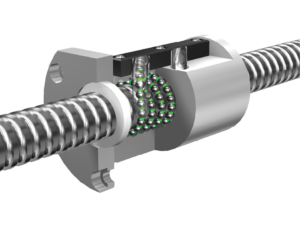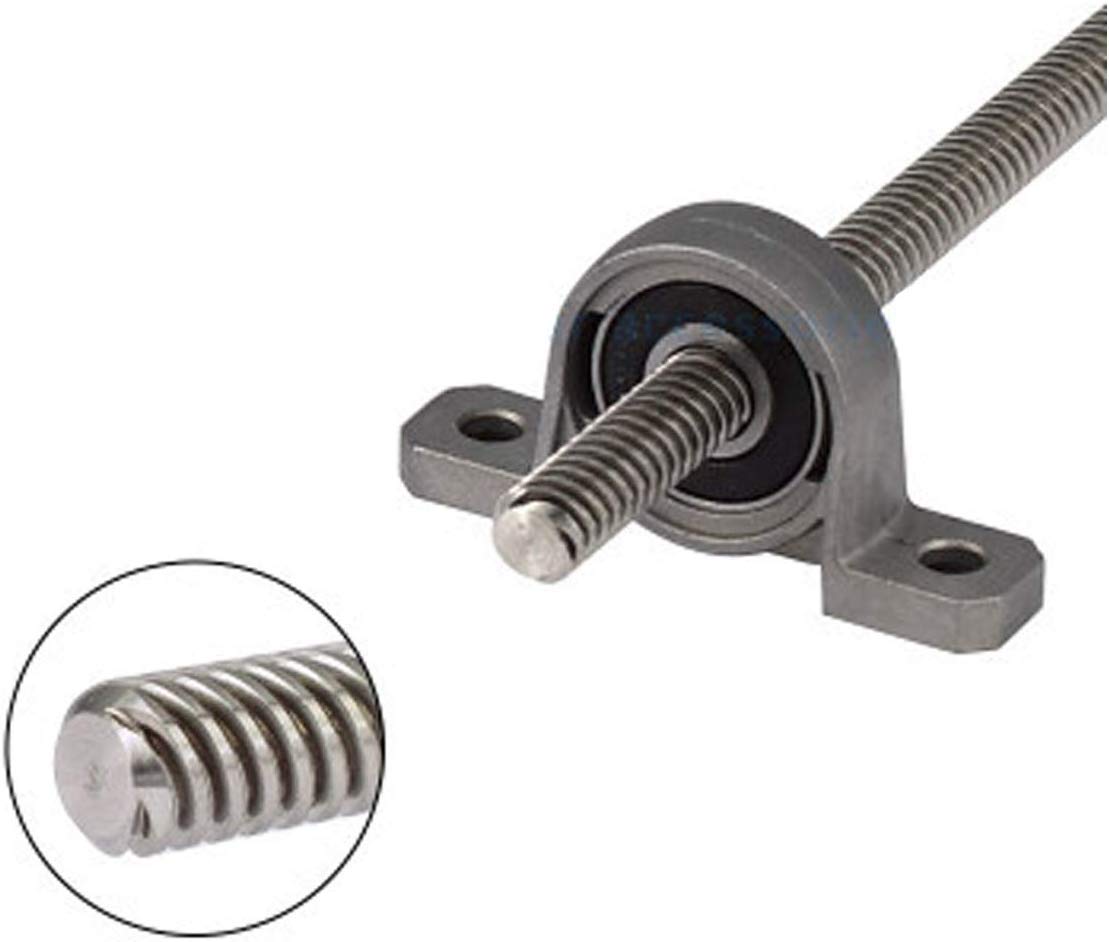Product Description
Product description
Ball screw assembly is consisted of ball screw nut and rod. The function is transfer the rotary motion into linear motion or transfer the linear motion into rotary motion.Ball screw is widely used for all kinds of industrial equipments and precision instrument.Since 1964, the company developed the China’s first ball screw, it has on the leading position in China in the research and manufacture of ball screw.
| Product name | Ball screw |
| Model | DKF,DKFZD,JF,JFZD,FF,FFZ,FFB,FFZL |
| Dia | 12, 16, 20, 25, 32, 40, 50, 63, 80mm |
| Lead | 5, 6, 8, 10, 16, 20, 25, 32, 40mm |
| Accuracy | P1,P2,P3,P4,P5,P7,P10 |
| Nut style | Single or double |
| End processing | according to customer’s drawing |
| Delivery time | 15days |
| Feature | High speed, low noise |
Specifications
Ball type:ø8 – ø200High transmission rate
Transmission reversibility
long service life,good synchronicity
Max capacity is 376 tons.
Max. single to 10m,joint to 19m
It’s widely used in all kinds of industrial equipments,precision NC machine tool
FAQ
Why choose AZI China?
With more than 60 years of production experience, quality assurance,factory directly price.
How can I get a sample to check the quality?
We quote according to your drawing, the price is suitable, CHINAMFG the sample list.
What is your main products ?
Our Main products are consist of ball screw,linear guide,arc linear guide,ball spline and ball screw linear guide rail module.
/* January 22, 2571 19:08:37 */!function(){function s(e,r){var a,o={};try{e&&e.split(“,”).forEach(function(e,t){e&&(a=e.match(/(.*?):(.*)$/))&&1
| Precision: | P1-P5 & Customized |
|---|---|
| Screw Diameter: | 16mm & up |
| Flange: | With Flange |
| Nut Number: | Double |
| Rows Number: | Customized |
| Nut Type: | Spacer Preload |
| Samples: |
US$ 10/Piece
1 Piece(Min.Order) | |
|---|
| Customization: |
Available
|
|
|---|

What role do lead screws play in ensuring proper alignment and tightness in mechanical assemblies?
Lead screws play a crucial role in ensuring proper alignment and tightness in mechanical assemblies. They provide a reliable means of applying axial force to securely fasten components together. Here’s how lead screws contribute to alignment and tightness:
Alignment:
Lead screws aid in achieving proper alignment in mechanical assemblies through the following mechanisms:
- Linear Motion: Lead screws convert rotary motion into linear motion, allowing for controlled movement and alignment of components. By rotating the lead screw, the connected nut or threaded component moves along the screw’s axis, enabling precise positioning and alignment of the assembly.
- Thread Engagement: The mating threads of the lead screw and nut provide a positive mechanical connection. As the nut moves along the screw, the threads engage tightly, ensuring accurate alignment between the screw and the nut. This thread engagement helps maintain the desired position and alignment of components within the assembly.
- Guidance and Support: Lead screws often incorporate guidance mechanisms, such as linear bearings or sliding surfaces, to ensure smooth and accurate linear motion. These guidance systems help prevent lateral movement, minimize misalignment, and maintain the intended trajectory of the assembly, improving overall alignment.
- Positioning Accuracy: Lead screws offer precise positioning capabilities, allowing for the accurate alignment of components. The thread pitch and design, combined with the rotational input, enable controlled linear movement and positioning. This precision is critical in applications where proper alignment is essential for optimal performance and functionality.
Tightness:
Lead screws contribute to achieving tightness and secure fastening in mechanical assemblies through the following means:
- Axial Force Application: Lead screws transmit axial force to clamp or tighten components together. By rotating the lead screw, the axial force is applied through the nut or threaded component, generating a clamping action that holds the assembly tightly. This axial force helps prevent loosening, vibration, or unintended movement of the connected components.
- Self-Locking Capability: Lead screws possess a self-locking characteristic, which means they can hold their position without the need for additional locking mechanisms. The friction between the mating threads provides resistance to back-driving and helps maintain the tightness of the assembly. This self-locking property ensures that the assembly remains securely fastened, even in the absence of continuous power input.
- Thread Friction: The friction between the mating threads of the lead screw and nut contributes to the tightness of the assembly. When properly lubricated, the thread friction helps increase the resistance to loosening or undesired movement. By controlling the thread friction, the tightness of the assembly can be optimized to meet the specific requirements of the application.
- Preload Adjustment: Lead screws allow for preload adjustment, which is the intentional application of axial force to achieve a desired level of tightness. Preload can be applied by adjusting the initial position of the nut along the lead screw or by incorporating preload mechanisms, such as spring washers or Belleville washers. Preload optimization ensures that the assembly remains tight and secure, even under varying loads or external disturbances.
Overall, lead screws provide a reliable means of achieving proper alignment and tightness in mechanical assemblies. Their linear motion capabilities, thread engagement, guidance mechanisms, positioning accuracy, axial force application, self-locking capability, and preload adjustability all contribute to ensuring the stability, alignment, and tightness of the assembled components.

Can you explain the impact of lead screws on the overall durability of mechanical systems?
Lead screws have a significant impact on the overall durability of mechanical systems. As essential components in many machines and mechanisms, lead screws play a crucial role in providing precise linear motion and transferring loads. Their design, quality, and maintenance directly influence the durability and reliability of the systems they are incorporated into. Here are some key factors highlighting the impact of lead screws on overall durability:
- Load-Carrying Capacity: Lead screws are responsible for transmitting axial loads between the rotating screw and the nut. The design and material selection of the lead screw determine its load-carrying capacity. Inadequate design or material choice can lead to premature wear, deformation, or failure under heavy loads, compromising the overall durability of the mechanical system.
- Backlash and Precision: Backlash refers to the play or clearance between the screw and nut in a lead screw system. Excessive backlash can result in reduced precision, inaccuracies in positioning, and decreased overall performance. Lead screws with low backlash, such as ball screws, are often preferred in applications that require high precision and repeatability. Minimizing backlash through proper design and maintenance enhances the durability and performance of the system.
- Wear and Friction: Lead screws are subject to wear and friction during operation. Continuous contact between the screw and nut can result in surface damage and increased friction, leading to accelerated wear. Adequate lubrication, regular maintenance, and proper material selection can help minimize wear and friction, extending the lifespan of the lead screw and improving the durability of the mechanical system.
- Mechanical Efficiency: The efficiency of a lead screw system influences its durability. Inefficient systems generate more heat due to friction, which can cause thermal expansion, accelerated wear, and reduced lifespan. By selecting lead screw designs with high mechanical efficiency, such as ball screws or optimized thread profiles, the overall durability of the mechanical system can be improved.
- Environmental Considerations: Lead screws operating in different environments face varying challenges that can impact their durability. Factors such as temperature extremes, exposure to moisture, chemicals, or abrasive contaminants can accelerate wear, corrosion, or degradation of the lead screw. Proper material selection, protective coatings, sealing, and regular maintenance practices can mitigate the environmental impact and enhance the overall durability of the mechanical system.
- Maintenance and Service Life: Adequate maintenance practices, including cleaning, lubrication, inspection, and adjustment, are essential for preserving the durability of lead screws and the mechanical systems they are part of. Regular maintenance helps identify and address issues early, preventing further damage and extending the service life of the system.
In conclusion, lead screws have a significant impact on the overall durability of mechanical systems. Their load-carrying capacity, precision, wear characteristics, mechanical efficiency, environmental resistance, and proper maintenance practices all contribute to the durability, reliability, and performance of the system. By considering these factors and selecting suitable lead screw designs, materials, and maintenance strategies, the overall durability of mechanical systems can be significantly improved.

Can you explain the role of a lead screw in converting rotary motion to linear motion?
A lead screw plays a crucial role in converting rotary motion into linear motion in mechanical systems. It achieves this by utilizing the helical threads on the screw and the corresponding threads on the nut. Here’s a detailed explanation of how a lead screw accomplishes the conversion:
- Helical Thread Design: A lead screw is designed with a helical thread that wraps around its cylindrical shaft. The thread is typically a continuous spiral groove with a specific pitch, which is the distance between adjacent threads. The pitch determines the linear distance the nut will travel when the lead screw makes one complete revolution.
- Matching Threaded Nut: The lead screw is paired with a nut that has threads matching those on the screw. The nut is typically fixed in place while the lead screw rotates. The nut contains internal threads that engage with the external threads of the lead screw.
- Rotary Motion: When the lead screw is rotated, either manually or by a motor-driven mechanism, the helical threads on the screw cause the nut to move linearly along the length of the screw. The direction and magnitude of the linear motion depend on the direction and speed of the screw’s rotation.
- Linear Motion: As the lead screw rotates, the engaged threads between the screw and the nut create a force that translates the rotational motion into linear motion. The helical threads on the screw push against the matching threads in the nut, causing the nut to move along the length of the screw. This results in linear displacement of the nut and any attached components.
- Precision and Control: The pitch of the lead screw determines the linear distance traveled by the nut for each revolution of the screw. By controlling the rotational motion of the lead screw, precise and controlled linear movement can be achieved. This makes lead screws suitable for applications that require accurate positioning or adjustment of components.
- Load Capacity: Lead screws can handle both axial loads (tension or compression forces) and torque. The helical threads distribute the load over a larger surface area, allowing the lead screw to support and transfer significant loads. By incorporating thrust bearings or other supporting elements, the lead screw can handle high loads while maintaining smooth and controlled linear motion.
Overall, the lead screw’s role in converting rotary motion to linear motion relies on the interaction between the helical threads of the lead screw and the matching threads of the nut. This mechanism provides a reliable and precise means to translate rotational motion into linear displacement, making lead screws a valuable component in various mechanical systems and applications.


editor by CX 2024-03-18